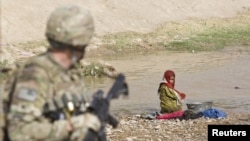NEW YORK - The United Nations Assistance Mission in Afghanistan (UNAMA) says civilian casualties from the Afghan conflict remain at "unacceptably high levels" despite a 21-percent drop in conflict-related deaths during the first four months of this year.
In a report released Thursday, UNAMA said 2011 marked the fifth year in a row in which civilian casualties increased in Afghanistan. The group said it documented more than 3,000 civilian deaths last year, three-quarters linked to violence by anti-government forces.
The continued violence has raised concerns about the ability of Afghan forces to handle security beyond 2014, when most NATO forces are planning to conclude their combat role.
Brookings Institution Foreign Policy Senior Fellow Michael O'Hanlon says he does not expect a significant decrease in the conflict-related deaths in the near future.
"I am just not persuaded that there is any realistic hope that the numbers are going to go down that much in the next two or three years," said O'Hanlon. "I think that unless the Taliban decides to be serious about peace talks, we are probably going to have to hope the numbers just don't get much worse as we carry out a transition to primary Afghan responsibility for security throughout the country."
UNAMA said improvised explosive devices (IED's), used by anti-government forces, were the single largest killer of civilians, accounting for one-third of the deaths.
On Wednesday, the group said it had documented 579 civilian deaths for the first four months of 2012, a one-fifth decrease compared to the same time last year. However, it said the region's harsh winter may have contributed to the decrease.
Meanwhile, Afghan officials say explosions killed at least seven police officers on Thursday.
A spokesman for the provincial governor in Kandahar province says a car bombing at a police checkpoint in Argistan killed at least five officers.
There was no immediate claim of responsibility. Kandahar is the birthplace of the Taliban, which earlier this month announced the start of a spring offensive.
Afghan officials say a second explosion at a checkpoint in Jalalabad killed two police officers.
In a report released Thursday, UNAMA said 2011 marked the fifth year in a row in which civilian casualties increased in Afghanistan. The group said it documented more than 3,000 civilian deaths last year, three-quarters linked to violence by anti-government forces.
The continued violence has raised concerns about the ability of Afghan forces to handle security beyond 2014, when most NATO forces are planning to conclude their combat role.
Brookings Institution Foreign Policy Senior Fellow Michael O'Hanlon says he does not expect a significant decrease in the conflict-related deaths in the near future.
"I am just not persuaded that there is any realistic hope that the numbers are going to go down that much in the next two or three years," said O'Hanlon. "I think that unless the Taliban decides to be serious about peace talks, we are probably going to have to hope the numbers just don't get much worse as we carry out a transition to primary Afghan responsibility for security throughout the country."
UNAMA said improvised explosive devices (IED's), used by anti-government forces, were the single largest killer of civilians, accounting for one-third of the deaths.
On Wednesday, the group said it had documented 579 civilian deaths for the first four months of 2012, a one-fifth decrease compared to the same time last year. However, it said the region's harsh winter may have contributed to the decrease.
Meanwhile, Afghan officials say explosions killed at least seven police officers on Thursday.
A spokesman for the provincial governor in Kandahar province says a car bombing at a police checkpoint in Argistan killed at least five officers.
There was no immediate claim of responsibility. Kandahar is the birthplace of the Taliban, which earlier this month announced the start of a spring offensive.
Afghan officials say a second explosion at a checkpoint in Jalalabad killed two police officers.






